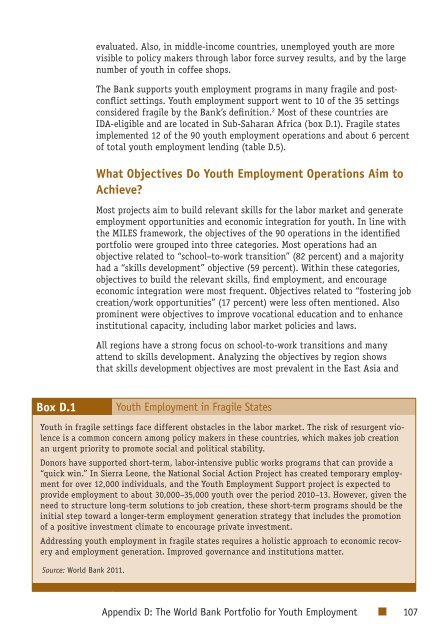Youth Employment Programs - Independent Evaluation Group
Youth Employment Programs - Independent Evaluation Group
Youth Employment Programs - Independent Evaluation Group
Create successful ePaper yourself
Turn your PDF publications into a flip-book with our unique Google optimized e-Paper software.
evaluated. Also, in middle-income countries, unemployed youth are morevisible to policy makers through labor force survey results, and by the largenumber of youth in coffee shops.The Bank supports youth employment programs in many fragile and postconflictsettings. <strong>Youth</strong> employment support went to 10 of the 35 settingsconsidered fragile by the Bank’s definition. 2 Most of these countries areIDA-eligible and are located in Sub-Saharan Africa (box D.1). Fragile statesimplemented 12 of the 90 youth employment operations and about 6 percentof total youth employment lending (table D.5).What Objectives Do <strong>Youth</strong> <strong>Employment</strong> Operations Aim toAchieve?Most projects aim to build relevant skills for the labor market and generateemployment opportunities and economic integration for youth. In line withthe MILES framework, the objectives of the 90 operations in the identifiedportfolio were grouped into three categories. Most operations had anobjective related to “school–to-work transition” (82 percent) and a majorityhad a “skills development” objective (59 percent). Within these categories,objectives to build the relevant skills, find employment, and encourageeconomic integration were most frequent. Objectives related to “fostering jobcreation/work opportunities” (17 percent) were less often mentioned. Alsoprominent were objectives to improve vocational education and to enhanceinstitutional capacity, including labor market policies and laws.All regions have a strong focus on school-to-work transitions and manyattend to skills development. Analyzing the objectives by region showsthat skills development objectives are most prevalent in the East Asia andBox D.1<strong>Youth</strong> <strong>Employment</strong> in Fragile States<strong>Youth</strong> in fragile settings face different obstacles in the labor market. The risk of resurgent violenceis a common concern among policy makers in these countries, which makes job creationan urgent priority to promote social and political stability.Donors have supported short-term, labor-intensive public works programs that can provide a“quick win.” In Sierra Leone, the National Social Action Project has created temporary employmentfor over 12,000 individuals, and the <strong>Youth</strong> <strong>Employment</strong> Support project is expected toprovide employment to about 30,000–35,000 youth over the period 2010–13. However, given theneed to structure long-term solutions to job creation, these short-term programs should be theinitial step toward a longer-term employment generation strategy that includes the promotionof a positive investment climate to encourage private investment.Addressing youth employment in fragile states requires a holistic approach to economic recoveryand employment generation. Improved governance and institutions matter.Source: World Bank 2011.Appendix D: The World Bank Portfolio for <strong>Youth</strong> <strong>Employment</strong> 107
















